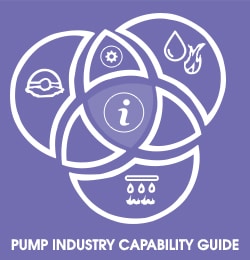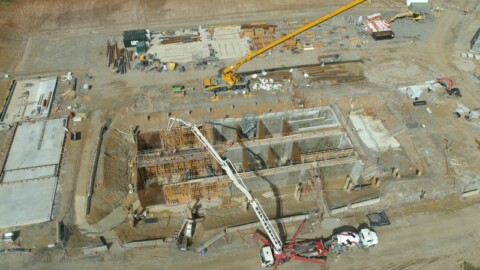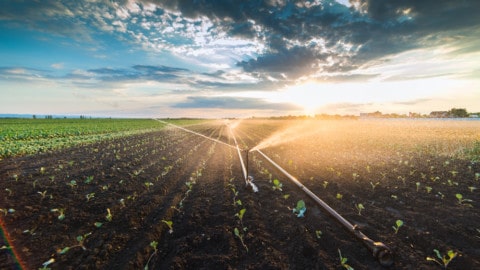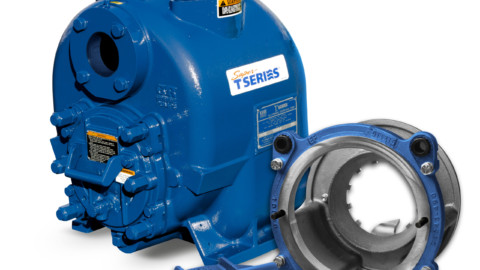In Victoria’s Goulburn Valley, two innovative farmers have revolutionised the irrigation and pumping systems on their property, significantly reducing water usage per hectare of land, and widening the range of crops they can produce. In recognition of their efforts, they were awarded first place in the Irrigation District Water Users category of the 2016 State Rural Water Awards.

Ian Hamono inspecting his maize crop grown on subsurface drip irrigation.
In 2008, when farmers Ian and Mary Hamono first purchased their farm in Cooma, Victoria, the land had previously been used for growing tomatoes and lacked a permanent irrigation system, the tomato growers having employed short term, removable irrigation infrastructure.
In the midst of the Millennium Drought, water prices were high and the Hamonos knew they couldn’t take unlimited, reliable water supply for granted.
“At the time I purchased this farm water prices were really expensive,” Ian Hamono told Pump Industry. “We were in the middle of a drought, and the long-term projection was the water prices were going to be expensive, and there was going to be a shortfall of water. I was really looking for an efficient way of irrigating my summer crops into the future.”
So the couple began to research and plan an efficient, effective irrigation system that would maximise yield for each unit of water used, keep costs down, and see them well into the future.
Now in 2017, they have state-of-the-art irrigation systems, including a 160-hectare subsurface drip irrigation system, installed on the property, and are reaping the benefits of their investment.
Installing an innovative irrigation system
The new irrigation system was eight years in the making and encompassed a three-stage project.
For each stage Ian and Mary Hamono exchanged water entitlements in return for government investment in on-farm efficiency improvements through the Australian Government’s $626 million On-Farm Irrigation Efficiency Program. This program aims to assist irrigators in the southern connected system of the Murray–Darling Basin to modernise their on-farm irrigation infrastructure while returning water savings to the environment.
But before installation works could begin, the Hamonos had to undertake significant planning and research to identify the ideal irrigation infrastructure for their intended applications.
“It was really a matter of going out and talking to others that had done it,” said Mr Hamono. “Talking to suppliers and equipment manufacturers about the latest technologies and trends. And I wanted to install something that was not only suitable today, but was going to be there in the future.”
Every minute detail had to be considered in order to design the most effective systems.
“We had to consider tape spacing, what sort of emitter application rates were required. What sort of filtration, what pumps,” said Ian Hamono. “There’s a whole range of factors. What sort of control system. What sort of valve. How to control field valves. There are old traditional hydraulic systems, then multi-wire systems, two-wire systems, and there’s radio. It was really a matter of working through all those sorts of technologies.”
Once the planning was complete, on-ground installation works could begin. The on-farm works have included pump installation, channel construction, laser grading, establishing recycle dams, subsurface irrigation, and the installation of a centre pivot.
“The first subsurface system that I installed we did in two parts, 60 hectares each year for two years,” said Mr Hamono.
“The latest system that I’ve just finished installing, that was done over one season.”
“I installed a recycle system,” he said. “That was the first grant that I got, it enabled me then to install pumps on that recycled system, so that I could install a subsurface drip irrigation.
“I got a grant for the installation of centre pivot irrigation. I also got a couple of grants to upgrade some of the other parts of my property into high-flow flood irrigation. That was primarily done so that I could irrigate winter crops, to start them off in the autumn, and to finish them off in the spring, so that I basically reduced the risk of crop failure on those winter crops.”

Innovation leads to great inventions. The home built drip tape installation machine made by Ian.
Pumping water for efficient irrigation
The Hamonos’ farm now has a highly efficient and effective irrigation system in place, powered by an array of pumps, allowing them to grow a wide range of crops all year round.
“I grow summer and winter crops,” said Ian Hamono. “Winter crops are cereals, canola, soya beans, whatever grows basically, on a rotation. In summer all of the area that I’ve upgraded predominantly goes to corn.”
The irrigation system includes specially developed drip tape with a longer life expectancy, as well as a filter system to the pressurised pipe network that removes all fragments from the water, preventing blockages. The filter system is also capable of back flushing at lower pressure, putting less strain on the pumping system.
“I’ve really got three different portfolios,” said Mr Hamono. “I’ve got some flood irrigation, which is the traditional way that people have irrigated here for decades.
“I’ve got a centre pivot irrigator that covers about 65 hectares. Then I’ve got about 160 hectares of subsurface drip irrigation.
“They’re all pressurised systems, the subsurface drip irrigation pumps out of a dam. Basically, there are two systems, both pump out of dams. The water is then filtered, distributed in a main, distributed to a number of in-field valves that are controlled by a central processor unit that’s in the pump shed. It basically runs automatically. As for the drip lines, some are spaced a metre apart, some others are spaced a metre and a half apart, depending on what I’m growing on that country.

“The first system that I installed was installed by a company in Shepparton called Water Dynamics. The centre pivot irrigator was installed by Eagle i Machinery at Finley. The newest drip system that I’m installing is being installed by Water Plus Irrigation in Shepparton.”
The new irrigation systems couldn’t run without an array of pumps and valves to move and direct the water to where it’s needed.
“On the largest system that I’ve got, I’ve got two 55 kilowatt three-phase electric motors that supply water to ten pod disk filters. From there the water is conveyed via 375mm main line to a series of in-field valves,” said Mr Hamono.
“There are 27 of them on my large system. Those 27 valves supply about four and a half hectare blocks. Those field valves also have an inline disk filter on them, so that in the case that there’s a filter failure on the main filter, or some debris gets past it, it’s collected in the field valves, so that there is no chance of any debris getting into the drip tapes, and blocking the emitters.
“Those field valves are controlled by a little computer system that’s in the main pump shed. That control system also controls fertigation – just how much fertiliser I inject in the system at any time. It also controls the flushing of the main filter. It controls the field valves to tell them in what sequence to come on, or to turn on and turn off.”
Harvesting the benefits
The new irrigation systems have provided increased yield, significantly decreased labour input, and greater efficiencies – resulting in increased income for the farmers.
“Comparisons of water usage on the different types of irrigation systems have shown on average water savings of about 1.5ML/ha with subsurface drip irrigation,” Mr Hamono said.
“We’re also recording an increased yield of about one to two tonnes per hectare and we can irrigate more land.
“It eliminates the need for channels, structures, check banks and surface drains, allowing me to increase the total amount of land available for irrigation by about 3.5 per cent.”
However, Mr Hamono said that possibly the most significant benefit was increased flexibility in irrigation practices, including the ability to apply small amounts of water to finalise crops when full irrigations are not required.
“This system allows us to apply the right amount of water at the right time,” he said. “I can basically match water application to crop needs.”
“I know now with my corn plants over summer, on a week-to-week basis, how much water they need for growth, and I can add to that the evaporation I expect given the climatic conditions we’ve got. Then I can apply whatever irrigation water is needed at that stage too.”

Setting an example of best practice
While winning in the state category of the 2016 Rural Water Awards was a nice bonus, the Hamonos consider themselves to have just been “doing what needs to be done”.
“I really didn’t do this for any accolades or awards or recognition, or anything like that,” said Mr Hamono. “Having said that, it’s a terrific award, it’s a great achievement. It’s always good to showcase what the industry can do, and also provide some sort of leadership or inspiration for other people in the industry.”
The Hamonos hope that the success of their irrigation overhaul can inspire other irrigation end users to consider overhauling their own irrigation systems to reap similar benefits.
“Today, more and more farmers are adopting subsurface drip irrigation in the Goulburn Valley as they identify with its benefits and best practices,” said Mr Hamono.
“I’ve already had a couple of groups of people who have come past and called in to have a look at what I do, and how I do it.
“Some of them are already doing it themselves, while others are contemplating it. Yes, it’s been good in that regard, there’s no doubt about that. It does show what can be done,” he said.



















